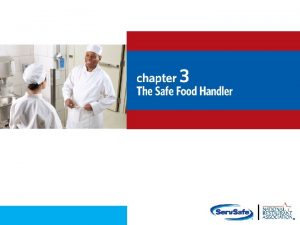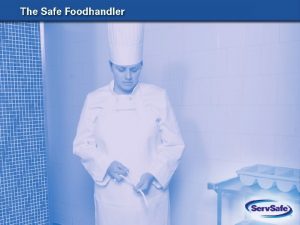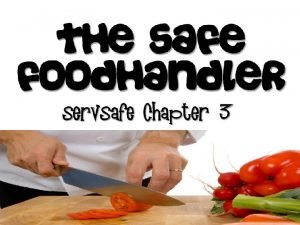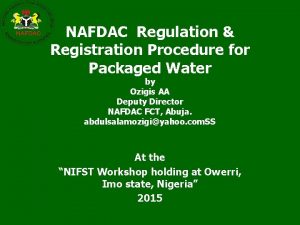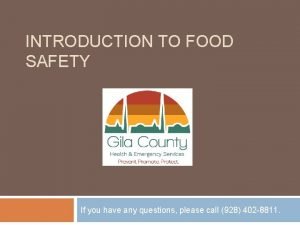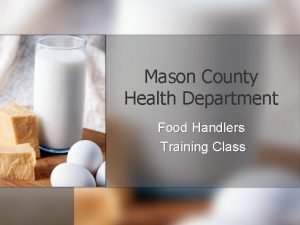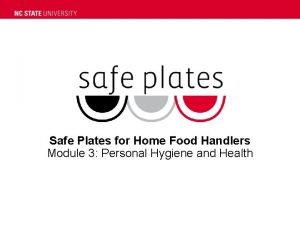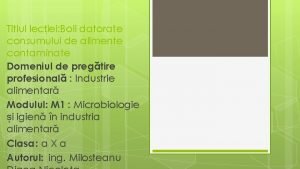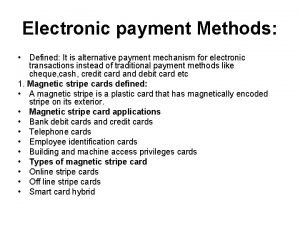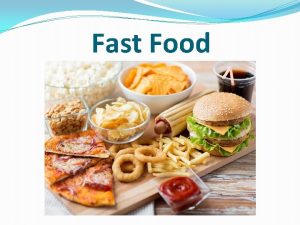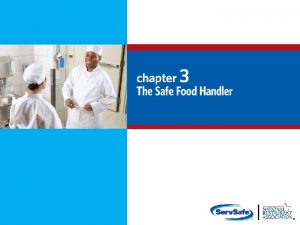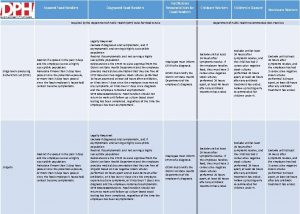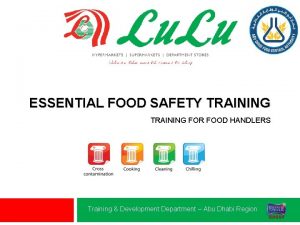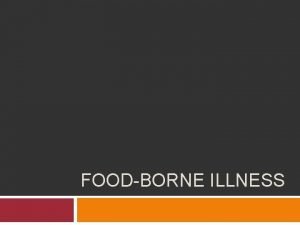How Food Handlers Can Contaminate Food handlers can











- Slides: 11


How Food Handlers Can Contaminate Food handlers can contaminate food when they: 3 -2 l Have a foodborne illness l Have wounds that contain a pathogen l Sneeze or cough l Have contact with a person who is sick l Touch anything that may contaminate their hands and do not wash them l Have symptoms such as diarrhea, vomiting, or jaundice—a yellowing of the eyes or skin

Managing a Personal Hygiene Program Managers must focus on the following: 3 -3 l Creating personal hygiene policies l Training food handlers on personal hygiene policies and retraining them regularly l Modeling correct behavior at all times l Supervising food safety practices l Revising personal hygiene policies when laws or science change

Infected Wounds or Cuts Infected wounds or cuts: l Contain pus l Must be covered to prevent pathogens from contaminating food and food-contact surfaces How a wound is covered depends on where it is located: 3 -4 l Cover wounds on the hand or wrist with an impermeable cover, (i. e. bandage or finger cot) and then a single-use glove l Cover wounds on the arm with an impermeable cover, such as a bandage l Cover wounds on other parts of the body with a dry, tight-fitting bandage

Single-Use Gloves Single-use gloves: l 3 -5 Should be used when handling ready-to-eat food o Except when washing produce o Except when handling ready-to-eat ingredients for a dish that will be cooked l Must NEVER be used in place of handwashing l Must NEVER be washed and reused l Must fit correctly

Single-Use Gloves How to use gloves: 3 -6 l Wash and dry hands before putting gloves on l Select the correct glove size l Hold gloves by the edge when putting them on l Once gloves are on, check for rips or tears l NEVER blow into gloves l NEVER roll gloves to make them easier to put on

Bare-Hand Contact with Ready-to-Eat Food Bare-hand contact with ready-to -eat food must be avoided: l l 3 -7 Some jurisdictions allow it but require: o Policies on staff health o Training in handwashing and personal hygiene practices NEVER handle ready-to-eat food with bare hands when you primarily serve a high-risk population

Handling Staff Illnesses If: The food handler has a sore throat with a fever Then: 3 -8 l Restrict the food handler from working with or around food l Exclude the food handler from the operation if you primarily serve a highrisk population l A written release from a medical practitioner is required before returning to work

Handling Staff Illnesses If: The food handler has at least one of these symptoms ● Vomiting ● Diarrhea Then: Exclude the food handler from the operation ● Before returning to work, food handlers who vomited or had diarrhea must meet one of these requirements ● Have had no symptoms for at least 24 hours 3 -9

Handling Staff Illnesses If: The food handler has jaundice Then: ● Food handlers with jaundice must be reported to the regulatory authority ● Exclude food handlers who have had jaundice for less than 7 days from the operation ● Food handlers must have a written release from a medical practitioner and approval from the regulatory authority before returning to work 3 -10

Handling Staff Illnesses If: The food handler has been diagnosed with a foodborne illness caused by one of these pathogens and has symptoms ● Hepatitis A ● Salmonella Typhi ● Enterohemorrhagic and shiga toxin-producing E. coli ● Norovirus ● Shigella spp. Then: l l 3 -11 Exclude the food handler from the operation Work with the food handler’s medical practitioner and/or the local regulatory authority to decide when the person can go back to work
 Food handlers can contaminate food when they:
Food handlers can contaminate food when they: When should hand antiseptics be used
When should hand antiseptics be used What personal behaviors can contaminate food?
What personal behaviors can contaminate food? After which activity must food handlers wash their hands?
After which activity must food handlers wash their hands? Nafdac food handlers test
Nafdac food handlers test Gila county food handlers
Gila county food handlers 123 food handlers
123 food handlers Safe plates module 3
Safe plates module 3 Boli datorate consumului de alimente contaminate
Boli datorate consumului de alimente contaminate Handler classification
Handler classification Payment handlers meaning
Payment handlers meaning Fast food can be defined as any food that contributes
Fast food can be defined as any food that contributes
